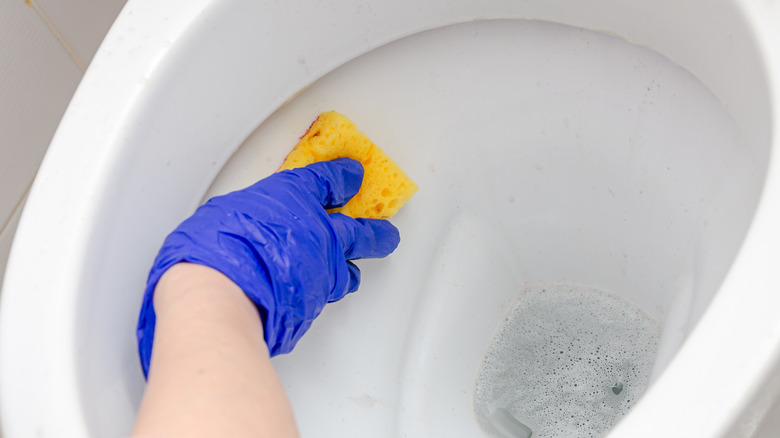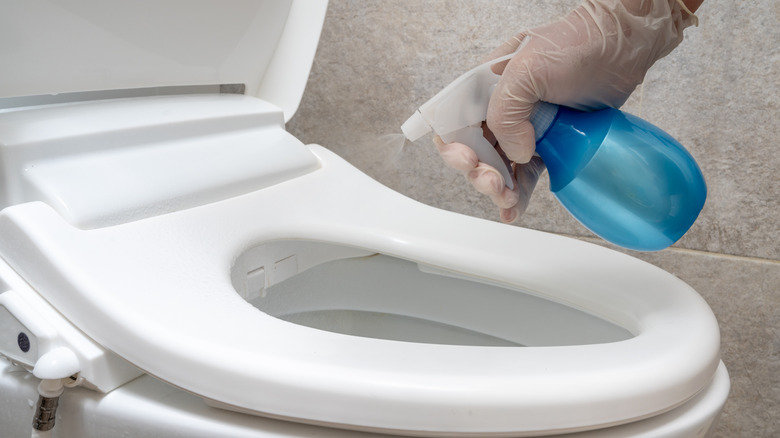The Undeniable Downside To Using Vinegar As A Toilet Cleaner
For homeowners who prefer natural cleaning ingredients, vinegar is a versatile cleaning tool for many areas of the home. Whether it's cleaning windows, removing hard water stains from bathroom fixtures, polishing mirrors, wiping down countertops, or mopping your floors, vinegar usually works well as a cleaner because it contains acetic acid, which can break down dirt, grime, grease, and limescale. Given how effective it is on many surfaces around the house, especially in the bathroom, you may be tempted to try it on your toilet. However, while vinegar can work wonders on rust and hard water stains in your toilet, there is a major drawback to using it as a toilet cleaner that may make you think twice: It is not registered as a disinfectant by the U.S. Environmental Protection Agency (EPA), which means it cannot kill all the germs and bacteria that might be living in your toilet.
To be labeled as a disinfectant, a substance must kill 99.9% of bacteria and viruses. While vinegar is effective at killing some germs responsible for foodborne illnesses, including E. coli and Salmonella, it doesn't meet disinfection standards. For effective toilet cleaning, rely on products with proven disinfecting properties, such as bleach or hydrogen peroxide.
Instead of vinegar, use bleach to disinfect your toilet
Vinegar often misses up to 20% of pathogens. For example, vinegar isn't effective for killing SARS-CoV-2, the virus responsible for COVID-19, which means your family can still get sick if you rely on it to deep-clean and disinfect your toilets. So, cleaning your toilet the right way involves removing stains and killing germs inside the bowl. Bleach is a highly effective disinfectant, but it isn't the most effective stain or dirt remover. However, many commercially available liquid toilet bowl cleaners are bleach-based formulas that clean and disinfect in one step, helping save time during cleaning.
You can also make your own diluted bleach solution to disinfect your toilet. Use unscented bleach, clearly labeled as containing 5% to 9% sodium hypochlorite, to ensure it effectively kills germs. Dilute the bleach by mixing 4 teaspoons into a quart of room-temperature water. You can mix the solution in a bucket and use a sponge to apply it to the toilet, or add it to a spray bottle to spray it over the toilet surface.
After cleaning your toilet with a non-bleach household cleaner to remove dirt and stains, rinse and dry it thoroughly, then sponge or spray the bleach solution onto the rim and inside the bowl. Allow it to sit on the surface for 5 minutes, then rinse with clean water and let it air dry. Cleaning with bleach can be dangerous, so it's important to take safety precautions. Open a window in your bathroom to ensure adequate ventilation, and wear rubber gloves to protect your skin from accidental spills. Never mix bleach with other cleaning products, acids, or chemicals like ammonia, because you can create very dangerous combinations.
Disinfect your toilet with hydrogen peroxide
If you prefer a gentler method for cleaning and disinfecting your toilet, hydrogen peroxide is an excellent alternative to bleach, as well as vinegar. In fact, you'd be surprised by what happens when you pour hydrogen peroxide into your toilet. Add a cup of the peroxide to your toilet, carefully pouring around the entire interior of the bowl. Allow it to sit for at least 30 minutes to visibly lighten rust or hard water stains.
To disinfect the interior of your toilet, the rim, seat, and other surfaces, mix 1 part hydrogen peroxide with 1 part water in a spray bottle. Just as with bleach, you should clean the toilet of any visible dirt and stains with a household cleaner before disinfecting with diluted hydrogen peroxide. Spray the solution over the toilet, and allow it to sit for at least 5 minutes. Use a damp cloth or sponge to rinse the surface, and then let the toilet air dry. While hydrogen peroxide is gentler than bleach, it still requires a few safety precautions. Ensure adequate ventilation by opening a bathroom window as you clean, and wear protective gloves to prevent skin irritation.


